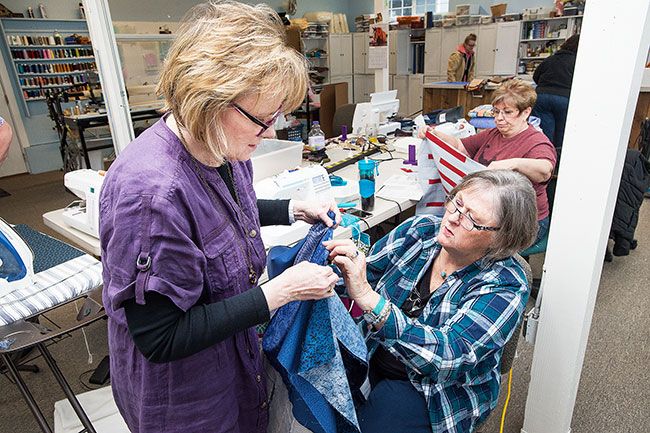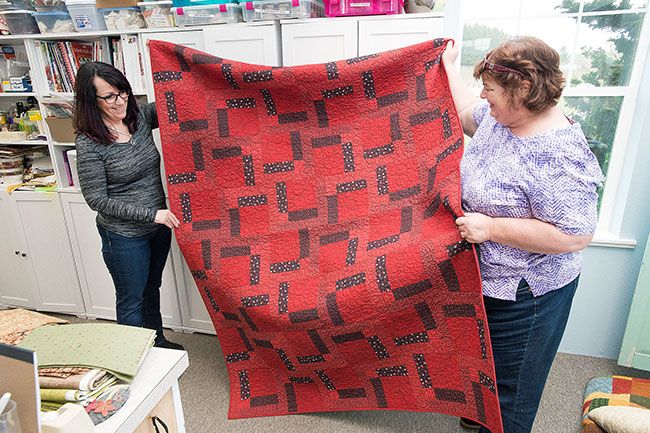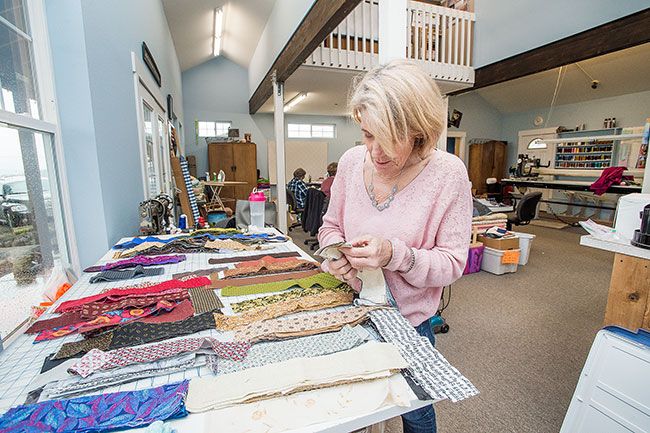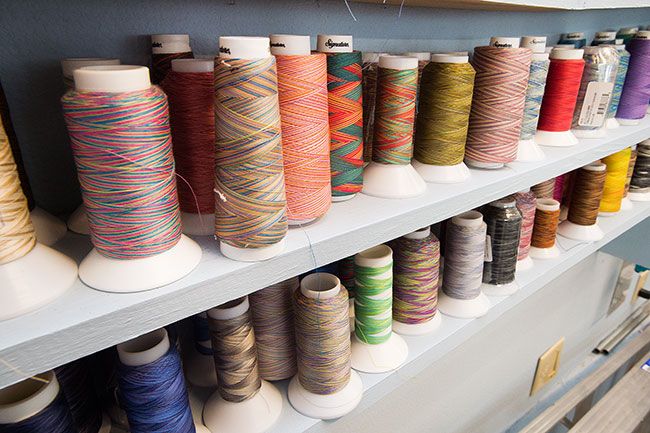Stopping By: Piece officers
So Bebereia, a retired 911 dispatcher, decided to do something to comfort the ones who are injured on duty.
The most comforting thing she can think of is a handmade quilt. So Bebereia, a quilter and former quilt shop owner, decided to launch “Quilts for Cops.” The program provides quilts to first responders in need of some emotional or physical comfort.
“The injured are often forgotten,” she said. “Their scars may not be evident anymore, but they still need attention. We’d like to think our quilts have special healing powers.”
The only trouble is, the volunteers can’t piece and sew and quilt quite fast enough. Though they’ve shipped out 34 quilts since Jan. 1, five in the first week of March alone, they can’t keep up with the need.
“I have 84 recipients in line,” said Bebereia, who collects information from all over the country. “I get about 10 more a week. On Monday or Tuesday, there were five officers injured in 24 hours.”
Ideally, she said, she’d like to catch up with the backlog, then keep pace from there on.
To do that, she needs to recruit more volunteers to produce tops. They need to be plain, sturdy, high-quality tops of heavyweight cotton, designed for 60-by-80 quilts.
The nonprofit also accepts cash donations to fund backing fabric and batting, the middle layer of the quilt. Donations also cover shipping, which costs about $25 per quilt.
“We’ll take all the help we can get,” Bebereia said.
For many years, Bebereia has been sewing pieces of fabric into beautiful patterns, layering pretty tops with batting and backing, and stitching the layers together to produce finished quilts.
She grew up sewing in 4-H clubs and making her own clothes for high school. She and her sister also did cross stitch and other needlework crafts.
She completed her first small quilt — by hand, not machine — for her first daughter, Amanda. Now 31, Amanda has received quite a few quilts over the years.
“I liked quilts because they were beautiful and practical,” said Bebereia, who spent 20 years working as a dispatcher in Washington County.
At the time, Bebereia said, it was difficult to find someone to put the finishing touch on a large project.
It takes a huge, specialized sewing maching called a “long-arm” to stitch (or “quilt”) to the center of a bed-size quilt. Only a couple of people in the area had long-arm machines back then, she said.
Her quilting habit — er, hobby — eventually grew to the point where Bebereia decided to buy her own long-arm machine about 18 years ago.
After two years of practicing with it, she started professionally quilting for others. She could quilt while spending time with her second daughter, Emily, who was still young.
Soon, she opened a quilt shop in her home near Yamhill, selling fabric, notions and tools.
The Quilted Hill quickly became a hit with quilters from around the state, and even out of state. Better Homes & Gardens named it one of the nation’s top shops.
The business grew to the point that the Bebereias built a separate building to hold the shop and provide space for quilting classes.
After being injured in a car wreck, Bebereia closed The Quilted Hill. It was briefly reopened by one of her daughters, but closed again last year.
Throughout her long-arm lessons and days running the shop, Bebereia kept on quilting. And in the back of her mind, she kept thinking about using quilts to help the first responders with whom she worked and felt a kinship.
“I toyed with the idea for a while,” she recalled.
She made and sent out about a dozen quilts on her own. Then, last year, she made it official, applying and winning nonprofit status for Quilts for Cops. She went on to launch a web page, www.quiltsforcops.com, then a Facebook page.
Bebereia reached out to her friends, both from the quilting world and from her former workplace. Some area women, such as Val Landauer of Yamhill, contribute quilt tops. Others create fabric kits.
Right now, Bebereia’s neighbor, Tammy Laughlin, is working on a top using brown and cream batiks.
Other friends and new aquaintances begin visiting the former Quilted Hill each Friday for a Quilts for Cops work party. “We all have an interest in law enforcement, and we all get along,” Bebereia said.
Hope Sprunger, one of the regulars, said, “It feels so good to do this. It just warms your heart.”
Sprunger invited a friend, former volunteer firefighter Susan Boyd, to join as well.
“I have a passion for helping others,” Boyd said. “This really hit home.”
Marlene Thomas met Bebereia when both were working as dispatchers. Thomas is currently working as a property and evidence officer in Cornelius.
She said she has always been interested in helping the police. And she’s always loved crafting — knitting, crocheting, sewing, embroidering and quilting.
She made a fancy shirt to wear when she showed her horse in high school. She later sewed clothes for her daugthers.
Joining the Quilts for Cops effort was a natural for her.
“I know how hard it is to be in law enforcement,” Thomas said. “And it’s nice to see quilts help someone feel appreciated.”
Jeri Trembly is also a retired dispatcher. She said she needed a hobby, and was delighted when Thomas and Bebereia offered to help her learn to sew as part of Quilts for Cops.
“I’m getting better and better,” she said. And she said, “I love the visiting and the comaraderie here.”
Usually, the women take a break from their work party and have lunch at a nearby restaurant, such as The Horse Radish in Carlton.
“Good lunches, good laughs,” she said. “ It’s fun and rewarding.”
At the work parties, there’s a job for everyone, from experienced quilters to novice sewers.
Some people gather up and sort fabrics. Since most of the quilts will go to men, Bebereia said, the makers tend to use neutrals such as blues, browns, blacks and greens, rather than pastels or a mix of bright colors.
They rarely work with large prints or novelty fabrics. Occasionally, though, they’ll work a print of fish or animals into a quilt that’s going to an injured game officer.
The quilt patterns are usually fairly simple, so they’re quick to piece. One pattern they use again and again includes thin blue lines — or, for firefighters, red lines.
Since many of the patterns are made with 2 1/2-inch wide strips, other volunteers may spend the work parties cutting those strips from larger pieces of fabric. They package strips of several colors into a kit that can be quickly sewn into a quilt top.
“We’re more about quantity than complexity until we get caught up with the list,” Bebereia said.
At each work party, several women bring sewing machines and patiently sew together two strips, then four, then eight, etc. Sometimes beginning sewers take on this role, improving their technique at the same time they’re creating a quilt top.
Other volunteers take the 60 by 80 finished tops and pair them with like-sized pieces of batting and backing. Bebereia said they often use soft flannel for the quilt backs to make them extra cozy — especially if they’re headed to colder parts of the country.
Bebereia does most of the finishing on her long-arm machine.
It takes about two hours to quilt each top, Bebereia said. It could take much longer if she used a special pattern, such as drawing numerous stars or leaves or flowers with the sewing machine.
She keeps the patterns for these quilts very basic. She said she intends for them to be used, rather than admired from a distance.
The finishing touch is binding: a strip of fabric, often in a contrasting color, sewn around the circumference of the quilt. That takes about an hour using a regular sewing machine, she said.
The quilts finished near Yamhill go to first responders all over the country. Several have been sent to Oregon officers, including Oregon State Police trooper Nic Cederberg, a former Yamhill County resident who was critically injured in a shooting in December.
Recipients usually don’t know they’re getting a quilt until they open the package.
Some cannot respond, or aren’t ready to. But the Quilts for Cops volunteers are thrilled when they receive a thank-you card.
What they really love, Bebereia said, is hearing that the quilts are being used for their intended purpose. “We want people to use them,” she said, picturing a recovering officer wrapped in one of the quilts, starting to feel a little better.
Contact Starla Pointer at spointer@newsregister.com.
How to help
To learn more about helping Quilts for Cops, visit quiltsforcops.com. The Yamhill-based nonprofit also has a Facebook page under its name.
Founder Bobbie Abernathy-Bebereia said quilters who would like to make tops for the program need to follow a few common-sense rules. The tops need to be 60-by-80 inches and made from good-quality cotton fabric that will stand up to heavy use. Muted colors are preferred.
Financial support is also welcome. For more information, call 503-662-4052 or send an e-mail to quiltsforcops@gmail.com.













Comments